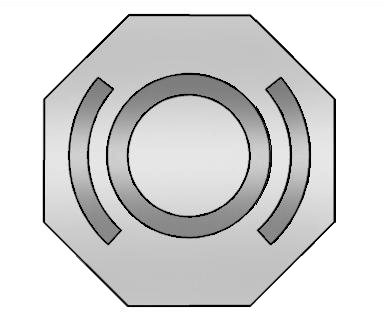Chevrolet Sonic Repair Manual: Brake Fluid

The brake/clutch master cylinder reservoir is filled with DOT 3 brake fluid as indicated on the reservoir cap. See Engine Compartment Overview for the location of the reservoir.
There are only two reasons why the fluid level in the reservoir might go down:
- The fluid level goes down because of normal brake lining wear. When new linings are installed, the fluid level goes back up.
- A fluid leak in the brake/clutch hydraulic system can also cause a low fluid level. Have the brake/clutch hydraulic system fixed, since a leak means that sooner or later the brakes and/or clutch will not work well.
Do not top off the brake/clutch fluid. Adding fluid does not correct a leak. If fluid is added when the linings are worn, there will be too much fluid when new brake linings are installed. Add or remove brake fluid, as necessary, only when work is done on the brake/clutch hydraulic system.
Warning:
If too much brake fluid is added, it can spill on the engine and burn, if the engine is hot enough. You or others could be burned, and the vehicle could be damaged. Add brake fluid only when work is done on the brake/clutch hydraulic system.
When the brake/clutch fluid falls to a low level, the brake warning light comes on. See Brake System Warning Light.
What to Add
Use only new DOT 3 brake fluid from a sealed container. See Recommended Fluids and Lubricants.
Always clean the brake/clutch fluid reservoir cap and the area around the cap before removing it. This helps keep dirt from entering the reservoir.
Warning:
With the wrong kind of fluid in the brake/clutch hydraulic system, the brakes might not work well. This could cause a crash. Always use the proper brake/clutch fluid.
Notice:
- Using the wrong fluid can badly damage brake/clutch hydraulic system parts. For example, just a few drops of mineral-based oil, such as engine oil, in the brake hydraulic system can damage brake hydraulic system parts so badly that they will have to be replaced. Do not let someone put in the wrong kind of fluid.
- If brake fluid is spilled on the vehicle's painted surfaces, the paint finish can be damaged. Be careful not to spill brake fluid on the vehicle. If you do, wash it off immediately.
 Brake Dust Warning
Brake Dust Warning
Warning: Avoid taking the following actions when you service wheel
brake parts:
Do not grind brake linings.
Do not sand brake linings.
Do not clean wheel brake parts with a dry brus ...
 Brake Fluid Effects on Paint and Electrical Components Caution
Brake Fluid Effects on Paint and Electrical Components Caution
Caution: Avoid spilling brake fluid onto painted surfaces, electrical
connections, wiring, or cables. Brake fluid will damage painted surfaces and
cause corrosion to electrical components. If ...
Other materials:
Parking Brake Adjustment (Drum Brake)
Note: The park brake cable adjusting nut is a nylon lock type. Use
ONLY HAND TOOLS whenever tightening or loosening the adjusting nut.
Apply and fully release the park brake several times. Verify that the park
brake lever releases completely.
Turn ON the ignition. Verify the red B ...
Special Tools
Illustration
Tool Number/ Description
CH-24319-B
CH-43631
J-24319-B
J-43631
Ball Joint Remover
CH-50559
Wheel Hub / Bearing Remover / Installer Kit
CH-5 ...
Low and Reverse and 1-2-3-4 Clutch Housing, Low and Reverse Clutch Assembly,
Output Sun Gear, and 2-6 Clutch Plate Disassemble (Gen 2)
Low and Reverse and 1-2-3-4 Clutch Housing, Low and Reverse Clutch
Assembly, Output Sun Gear, and 2-6 Clutch Plate Disassemble
Callout
Component Name
1
1??? Clutch Backing Plate
2
1??? Clu ...
0.0048
